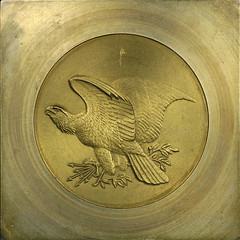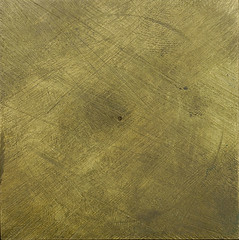
PREV ARTICLE
NEXT ARTICLE
FULL ISSUE
PREV FULL ISSUE
GOBRECHT PATTERN HUB REDUCTION DISCOVERED
On April 15th CoinWeek published an article from Numismatic Guaranty Corporation about a recently discovered U.S. Mint hub reduction, a rare and interesting transitional component in the minting process. Here's an excerpt; be sure to read the complete article online. Thas to Dave Lange of NGC for forwarding the photos used here; they were taken by Doug Plasencia of NGC before slabbing.
-Editor


Front and Back Numismatic Guaranty Corporation (NGC) has authenticated a previously unreported brass hub reduction produced at the United States Mint from an eagle designed by famed US Mint Engraver Christian Gobrecht. A hub reduction represents a transitional piece between the sculpted model and the hub used to create coining dies. This square piece came to NGC in a most unusual manner. NGC grader John Schuch was an instructor at last year’s American Numismatic Association Summer Seminar, and among his students was Alexandrea Zieman. She told John that her father, John Zieman, Jr., owned an unidentified brass plate bearing an eagle that they believed to be of US Mint origin. Alexandrea asked John to meet with her and her father at the Summer Fun Convention in Orlando just a few weeks later, and it was then that the item was submitted to NGC for authentication and grading. All that was known initially about the brass trial is that within its square was a hub image of silver dollar size depicting a Gobrecht eagle not known to have been used with any dollar patterns. This same device, however, had been reduced to half dollar size for use on silver and copper half dollar patterns dated 1838. These are varieties Judd-80 and -81, respectively. That die marriage combined the Seated Liberty No Drapery figure adopted for circulation the following year with a defiant eagle soaring upward, grasping a bundle of arrows in one claw and an olive branch in the other. This eagle die was not used with any other pattern strikings, and it is not known for any denomination other than the half dollar. To determine the authenticity of this unusual piece NGC sought out the most extensive collection of Gobrecht sketches and trial strikes—that held by the Smithsonian Institution’s National Numismatic Collection. There, coin dealer, researcher and NGC consultant Jeff Garrett took photos of a hub trial and a die trial, both in brass, of the same eagle device. The only difference in design from the new specimen is that both of the Smithsonian’s trials had been reduced to half dollar size and were thus associated with the two known patterns, Judd-80 and -81. There were no dollar size impressions of this eagle device. The Smithsonian pieces are illustrated in Elvira Clain-Stefanelli’s article “From the Drawing Board of a Coin-Engraver: Sketches by Christian Gobrecht for the Coinage of 1836-1839,” published in the American Numismatic Association Anthology in 1991. Also seen in this article are extremely similar sketches in Gobrecht’s hand of this eagle image, which was designed by artist Titian Peale. Owner John Zieman, Jr. provided NGC with some background on how he came to obtain this hub reduction: “In May 2012 a local picker/estate liquidator bought out an estate in Homosassa, Fl. The home owner is believed to be 7th generation Patterson. The people who inherited it sold all contents to this picker. My good friend and a long time picker had an idea of what was there. He also heard lots of stuff already was thrown away before he bought it. After buying the items he knew Alexandrea and I collect coins, early American items, mint items, etc. so he brought them to me. I made several deals to buy a majority of the items he got. I received items starting in late 2012 through present. Our goal (Alex and me) is to keep these items together and let others see and learn from them.” Indeed, this item is accompanied by an extensive assortment of objects and documents obviously from the estate of Robert M. Patterson, Director of the Mint from 1835 to 1851. These include an engraved portrait believed to be that of Mr. Patterson’s father and the copper plate from which it was taken, a ring and several honorary certificates. Perhaps of most interest to numismatists is a letter from Chief Coiner Adam Eckfeldt to R. M. Patterson dated September 1, 1829 and reading as follows: The present private opportunity enables me to comply with my first intention of asking your acceptance of two specimens of the smallest coin of the United States. The issue having been made on the 4th of July 1829, it being the first of a new design, there having been very few struck on this day, are circumstances which together with our long acquaintance, friendly enter change [sic] of good feeling & interesting civilities form strong inducements to the affectionate. At the time of this presentation, Patterson was still six years away from being employed with the Mint, though he was no stranger to the institution. His father, Robert Patterson, had been Mint Director from 1806 until his death in 1824. The elder Patterson’s successor was Samuel Moore (1824-35), who also happened to be the younger Patterson’s brother-in-law. The US Mint was very much a family business during its first century. NGC has certified the newly-discovered hub reduction as NGC MS 65. Its composition is 64.5% copper and 34.7% zinc, with a few trace elements. The weight of this specimen is 74.1 grams. It measures 51mm across its flats, and the disc portion has the normal 38.1mm diameter of a silver dollar.
To read the complete article, see:
NGC Authenticates Newly Reported Gobrecht Brass Hub Reduction
(www.coinweek.com/featured-news/ngc-authenticates-newly-reported-gobrecht-brass-hub-reduction/)
The Numismatic Bibliomania Society is a non-profit organization promoting numismatic literature. See our web site at coinbooks.org. To submit items for publication in The E-Sylum, write to the Editor at this address: whomren@gmail.com To subscribe go to: https://my.binhost.com/lists/listinfo/esylum All Rights Reserved. NBS Home Page Contact the NBS webmaster 
|